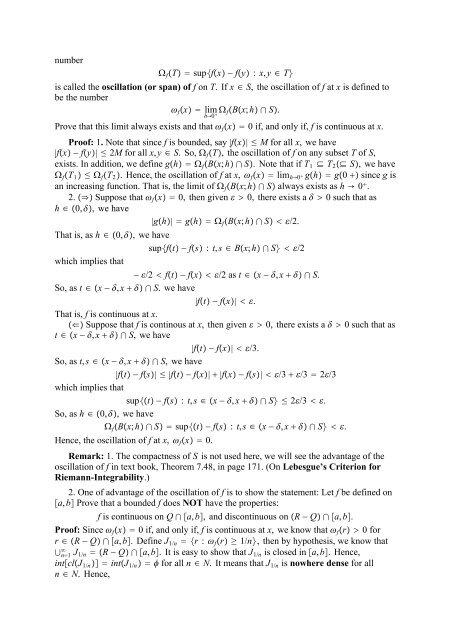The Real And Complex Number Systems
The Real And Complex Number Systems
The Real And Complex Number Systems
Create successful ePaper yourself
Turn your PDF publications into a flip-book with our unique Google optimized e-Paper software.
number<br />
f T supfx fy : x, y T<br />
is called the oscillation (or span) of f on T. Ifx S, the oscillation of f at x is defined to<br />
be the number<br />
f x lim <br />
h0<br />
<br />
fBx; h S.<br />
Prove that this limit always exists and that f x 0if,andonlyif,f is continuous at x.<br />
Proof: 1. Note that since f is bounded, say |fx| M for all x, wehave<br />
|fx fy| 2M for all x, y S. So, f T, the oscillation of f on any subset T of S,<br />
exists. In addition, we define gh f Bx; h S. Note that if T 1 T 2 S, wehave<br />
f T 1 f T 2 . Hence, the oscillation of f at x, f x lim h0<br />
gh g0 since g is<br />
an increasing function. That is, the limit of f Bx; h S always exists as h 0 .<br />
2. Suppose that f x 0, then given 0, there exists a 0 such that as<br />
h 0, , wehave<br />
|gh| gh f Bx; h S /2.<br />
That is, as h 0, , wehave<br />
supft fs : t, s Bx; h S /2<br />
which implies that<br />
/2 ft fx /2 as t x , x S.<br />
So, as t x , x S. wehave<br />
|ft fx| .<br />
That is, f is continuous at x.<br />
Suppose that f is continous at x, thengiven 0, there exists a 0 such that as<br />
t x , x S, wehave<br />
|ft fx| /3.<br />
So, as t, s x , x S, wehave<br />
|ft fs| |ft fx| |fx fs| /3 /3 2/3<br />
which implies that<br />
supt fs : t, s x , x S 2/3 .<br />
So, as h 0, , wehave<br />
f Bx; h S supt fs : t, s x , x S .<br />
Hence, the oscillation of f at x, f x 0.<br />
Remark: 1. <strong>The</strong> compactness of S is not used here, we will see the advantage of the<br />
oscillation of f in text book, <strong>The</strong>orem 7.48, in page 171. (On Lebesgue’s Criterion for<br />
Riemann-Integrability.)<br />
2. One of advantage of the oscillation of f is to show the statement: Let f be defined on<br />
a, b Prove that a bounded f does NOT have the properties:<br />
f is continuous on Q a, b, and discontinuous on R Q a, b.<br />
Proof: Since f x 0if,andonlyif,f is continuous at x, we know that f r 0for<br />
r R Q a, b. DefineJ 1/n r : f r 1/n, then by hypothesis, we know that<br />
<br />
n1 J 1/n R Q a, b. It is easy to show that J 1/n is closed in a, b. Hence,<br />
intclJ 1/n intJ 1/n for all n N. It means that J 1/n is nowhere dense for all<br />
n N. Hence,
















